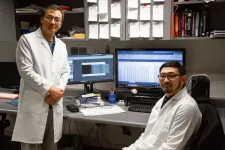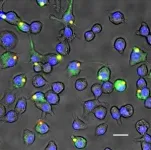(Press-News.org) FAMU-FSU College of Engineering researchers have created a new method for studying protein degradation within immune cells that uses engineered microparticles to track and analyze degradation processes more effectively than traditional methods.
The work, which was published in ACS Applied Materials & Interfaces, has important implications for treating diseases such as cancer, Alzheimer’s disease and autoimmune disorders.
“There is a lot we still don’t know about how cells ingest and eliminate tissue debris or pathogens — the process of phagocytosis,” said Jingjiao Guan, a professor in the Department of Chemical and Biomedical Engineering and a paper co-author. “Through this study, we hope to provide a new tool to help scientists better understand this process.”
This study focuses on understanding how proteins and peptides degrade within phagosomes — specialized compartments inside immune cells responsible for breaking down engulfed foreign particles or dead cells. Despite the crucial role of phagosomes in numerous immune responses, the exact mechanisms of how proteins and peptides degrade within them have remained unclear.
The approach pioneered by Guan’s lab uses engineered particles with fluorescent markers that allow researchers to observe their breakdown and formation into phagosome-derived vesicles, or PDVs. This method provides a real-time view of how immune cells process proteins and peptides, offering valuable insights into immune system function and dysfunction.
HOW IT WORKS
Scientists have traditionally studied phagocytosis by using tiny plastic and silica beads that are coated with proteins or peptides.
Although these bead-based methods are useful, they have some limitations. Each bead can only have a single layer of protein or peptide on it, and the beads themselves don’t do much beyond serving as a surface for the protein.
The primary innovation developed by Guan’s lab was developing microparticles that mimic natural biological structures.
These engineered particles can incorporate one or more types of proteins or peptides along with other materials into a well-defined layered structure, making them particularly valuable for mimicking the complex composition and structure of real-life particles.
The team used advanced microfabrication techniques to combine proteins and peptides with the polymer poly(N-isopropylacrylamide), or PNIPAM, in microparticles. This polymer exhibits unique responsive properties, making it an ideal tool for tracking and controlling microparticle activity under different conditions like temperature.
Guan’s approach enables microparticles to be engulfed and processed by immune cells, providing a unique model for studying cellular degradation mechanisms.
WHY IT MATTERS
This research has significant implications for the medical field, particularly in understanding immune system behavior in diseases such as cancer, spinal cord injuries and neurodegenerative disorders like Alzheimer’s. By demonstrating a new method to analyze protein degradation within immune cells, Guan’s study paves the way for deeper exploration of immune responses and potential therapeutic strategies.
“Knowing where proteins go and how much they are degraded when they undergo phagocytosis within cells is key to understanding this process,” Guan said.
One of the most promising aspects of the research is its potential application to Alzheimer’s disease. The team’s next phase involves investigating the degradation of the amyloid beta peptide, a protein associated with Alzheimer’s, using their engineered microparticles. This could offer new insights into the disease’s progression and identify targets for therapeutic intervention.
INTERDISCIPLINARY COLLABORATION AND FUTURE APPLICATIONS
Researchers from the FAMU-FSU College of Engineering collaborated with the FSU College of Medicine for this study.
“Collaborating with Dr. Guan has been an exciting opportunity to bridge engineering and medicine,” said Yi Ren, a professor in the College of Medicine and paper co-author. “This innovative approach to studying immune cell behavior is a significant step toward understanding disease mechanisms at a deeper level.”
Guan and his team are applying for grants to further their research and expand their study of microparticle applications in immune system-related diseases.
The particles can be used with any protein or peptide that can be purified and dissolved in water, making them useful tools for studying all manner of biological materials. There hasn’t been a comprehensive study comparing how different types of immune cells break down various proteins and peptides inside phagosomes, something that is now possible with this engineered microparticle.
By refining their techniques and exploring additional applications, the researchers hope to contribute to the development of treatment for more immune and neurodegenerative disorders.
“Working alongside Dr. Guan has been an incredibly rewarding experience,” said paper co-author and doctoral candidate Masahiro Fukuda. “Our study provides new insights that have the potential to transform how we understand and treat various diseases.”
Co-authors on this paper included Grace Lin, Sailesti Joshi and Sailesti Joshi from the FAMU-FSU College of Engineering and Yang Liu, Grace Hammel, Abigail Kizer and Maryam Ayazi from the FSU College of Medicine.
This research was supported by the National Institutes of Health.
END
FAMU-FSU College of Engineering researchers create innovative microparticles that unlock new insights into protein degradation and immune cell behavior
2025-03-27
ELSE PRESS RELEASES FROM THIS DATE:
Getting the ball rolling
2025-03-27
How gravity causes a perfectly spherical ball to roll down an inclined plane is part of elementary school physics canon. But the world is messier than a textbook.
Scientists in the Harvard John A. Paulson School of Engineering and Applied Sciences (SEAS) have sought to quantitatively describe the much more complex rolling physics of real-world objects. Led by L. Mahadevan, the Lola England de Valpine Professor of Applied Mathematics, Physics, and Organismic and Evolutionary Biology in SEAS and FAS, they combined theory, simulations, and experiments to understand what happens when an imperfect, ...
Breakthrough copper alloy achieves unprecedented high-temperature performance
2025-03-27
A team of researchers from Arizona State University, the U.S. Army Research Laboratory (ARL), Lehigh University and Louisiana State University has developed a groundbreaking high-temperature copper alloy with exceptional thermal stability and mechanical strength.
The research team’s findings on the new copper alloy, published in prestigious journal Science, introduce a novel bulk Cu-3Ta-0.5Li nanocrystalline alloy that exhibits remarkable resistance to coarsening and creep deformation, even at temperatures near its melting point.
“Our alloy design approach mimics the strengthening mechanisms found in Ni-based superalloys,” said Kiran Solanki, a professor at ...
Classroom talk plays a key part in the teaching of writing, study shows
2025-03-27
The way teachers manage classroom discussion with pupils plays a key role in the teaching of writing, a new study shows.
The research shows the importance of managing classroom discussion in a way that develops pupils’ understanding of the choices that writers make, and how those choices create particular effects for readers. This discussion helps pupils to think more about the choices that they make in their own writing.
The study reinforces the importance of dedicating time to discussion in secondary English lessons. It shows that time should be given to exploratory, speculative discussion that ...
Compelling data point to a single, unknown respiratory virus as cause of Kawasaki disease
2025-03-27
Research from Stanley Manne Children’s Research Institute at Ann & Robert H. Lurie Children’s Hospital of Chicago strongly suggests that Kawasaki disease is caused by a single respiratory virus that is yet to be identified. Findings contradict the theory that many different pathogens or toxins could cause this disease that can lead to serious cardiac complications in young children.
“The cause of Kawasaki disease has been a mystery for over 50 years,” said Anne Rowley, MD, pediatric infectious diseases expert and scientist at Manne Research Institute at Lurie Children’s, who is the lead author on the study published ...
Melting ice, more rain drive Southern Ocean cooling
2025-03-27
In brief
Surface waters in the Southern Ocean have been cooling in recent decades, counter to what climate models predict.
Scientists have quantified how much of the cooling observed since 1990 has been driven by an influx of freshwater that’s unaccounted for in state-of-the-art climate models.
The researchers discovered that freshwater inputs along the coast from melting ice sheets exert surprisingly strong influence on Southern Ocean surface temperatures and the broader climate system.
Global climate models predict that the ocean around Antarctica ...
Gasdermin D emerges as a potential therapeutic target for atrial fibrillation
2025-03-27
Atrial fibrillation (AF) is a common form of heart arrhythmia, a serious condition in which the heart beats so fast that its upper chambers, the atria, quiver. This irregular heartbeat can increase the risk of severe conditions, including heart failure, dementia and stroke.
“My lab has been studying the role of inflammation in the initiation and persistence of AF for many years. In this multidisciplinary study, we investigated the function of gasdermin D, a key participant in inflammatory pathways, in atrial heart cells and its potential contribution to AF,” said corresponding author Dr. Na Li, professor of medicine ...
Mapping the Earth’s crops
2025-03-27
As agricultural research continues to become more entwined with technology, smart farming – a phrase that encompasses research computing tools that help farmers to better address issues like crop disease, drought and sustainability – has quickly become a ubiquitous term in Ag labs across the country. The availability of NCSA resources like Delta for researchers, both nationally and on the University of Illinois Urbana-Champaign (U. of I.) campus, has fostered a hotbed of cutting-edge research projects in the agricultural domain.
Yi-Chia Chang, a Ph.D. student at the ...
Rideshare data reveal discriminatory policing for speeding in Florida
2025-03-27
Using data on more than 220,000 individuals on the Lyft rideshare platform, researchers report that drivers of color are significantly more likely to receive speeding tickets than white drivers, and to face steeper fines, even when traveling at identical speeds. Racial profiling by law enforcement is a pressing social issue in the United States. Previous research analyzing police and judicial records suggests that racial and ethnic minorities face disproportionately higher rates of searches, fines, force, detentions, and incarceration compared to white civilians. However, research on racial bias in policing has long been hindered by data limitations ...
Unique genetic mutation underlies horses’ exceptional athleticism
2025-03-27
Researchers have revealed a secret behind horses' exceptional endurance – a mutation in the KEAP1 gene that boosts energy production while protecting against cellular oxidative stress. The findings – which shed light on a unique evolutionary adaptation that has shaped one of nature’s most powerful athletes – hold potential implications for human medicine. They also highlight how the recoding of a de novo stop codon – a strategy thought restricted to viruses – can facilitate adaptation in vertebrates. Long prized for their speed and endurance, horses possess remarkable physiological adaptations ...
Dopamine-producing brain circuit drives eating “for pleasure” in mice
2025-03-27
A previously overlooked dopamine-producing brain circuit drives hedonic eating, or eating for pleasure, according to a new study in mice. The findings offer insights into how GLP-1 agonist drugs like semaglutide affect appetite suppression and why pleasing and delicious foods can override these drugs’ effects. In a related Perspective, Dana Small argues that the findings indicate that the inter-individual differences in the adaptation of this circuit in response to GLP-1 drugs may account for differences in treatment efficacy in humans. “Future work that aims to minimize such adaptation could offer a promising avenue for the development of ...



